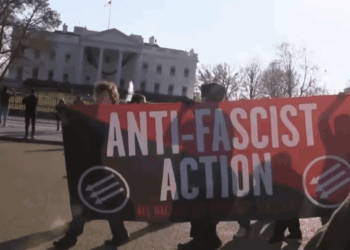
Order Michael Finch’s new book, A Time to Stand: HERE. Prof. Jason Hill calls it “an aesthetic and political tour de force.”
Sign up to attend Michael’s talk in Los Angeles on Thursday, November 20: HERE.
A bounty was placed by an illegal immigrant on the life of Border Patrol Chief Gregory Bovino, who oversees the joint ICE and Border Patrol immigration law enforcement campaign in the Chicago area known as Operation Midway Blitz. Rioters threw rocks and other dangerous objects at law enforcement agents, including a rock that was hurled in Mr. Bovino’s direction and hit him on the head. Rioters ignored law enforcement agents’ repeated orders to “back up” and “Get off the street.” Instead, they continued their acts of violence, which included shooting commercial artillery shell fireworks at agents and attacking a Border Patrol transport van that was carrying illegal immigrants. After the rioters were warned that tear gas would be used as a crowd control measure, if necessary, Mr. Bovino decided to deploy tear gas, which caused rioters to finally disperse.
But whom does U.S. District Judge of the United States District Court for the Northern District of Illinois, Judge Sara Ellis, blame for the chaos created by rioters? This judge, who was appointed by former President Barack Obama, blamed the Border Patrol Chief Bovino and the law enforcement agents he commands, of course.
Despite the clear public video evidence of the rioters’ responsibility for unlawful obstruction and the ensuing violence, Judge Ellis evidently relied on the word of illegal immigration advocates who filed the federal lawsuit to thwart Operation Midway Blitz. These plaintiffs complained that the immigration law enforcement agents were not complying with a previous order that Judge Ellis had issued limiting what these agents can do to control the riots. Referring to the use of chemical agents such as tear gas to disperse rioters, Judge Ellis said during a follow-up hearing that “This has been a consistent theme through all of the plaintiffs’ filings, is that there was no warning given” by immigration agents. If warnings were given, “There was no time to allow people to comply before the weapons were deployed.”
Judge Ellis told Mr. Bovino that “get back” or “get out of here,” are not proper warnings and that the mob must be given “time to disperse” before tear gas is used. This activist judge, sitting in the safety of her own chambers protected by court security officers, decided to micromanage how law enforcement agents control crowds that are threatening the agents with bodily harm.
Judge Ellis issued another order, which imposed further restrictions on methods of riot control and ordered Border Patrol Chief Bovino to provide daily reports to the court in person about “use of force activities.”
The Department of Justice appealed Judge Ellis’s order to the United States Court of Appeals for the Seventh Circuit. It asked the federal appeals court to “issue a writ of mandamus directing the district court to vacate its order.”
“That unprecedented order interferes with Chief Bovino’s ability to undertake his responsibilities,” the Department of Justice stated in its filing. “Requiring a senior executive official to appear for daily questioning far exceeds the recognized bounds of discovery. The order significantly interferes with the quintessentially executive function of ensuring the Nation’s immigration laws are properly enforced by waylaying a senior executive official critical to that mission. And the order only underscores the extent to which the court has exceeded its judicial role by implementing vastly overbroad relief and arrogating to itself the role of supervising and micromanaging the day-to-day operations of Executive Branch law enforcement agencies.”
In a short unsigned opinion, the Seventh Circuit Court of Appeals granted the Department of Justice’s petition for a writ of mandamus solely with respect to Judge Ellis’s daily in-person court appearance requirement. The appeals court criticized this requirement, concluding that Judge Ellis’s “order infringes on the separation of powers.” As the appeals court explained: “First, it puts the court in the position of an inquisitor rather than that of a neutral adjudicator of the parties’ adversarial presentations. Second, it sets the court up as a supervisor of Chief Bovino’s activities, intruding into personnel management decisions of the Executive Branch.”
The appeals court is still reviewing other portions of Judge Ellis’s order restricting law enforcement agents’ use of what they consider to be necessary crowd-control devices to manage ongoing violent protests after warnings to disperse are ignored.
Last June, the Supreme Court addressed overreaching by some federal district court judges in a 6-3 opinion written by Justice Amy Coney Barrett. “When a court concludes that the Executive Branch has acted unlawfully,” Justice Barrett wrote, “the answer is not for the court to exceed its power, too.”
Justice Barrett added, in response to Justice Ketanji Brown Jackson’s sharply worded dissent, “JUSTICE JACKSON decries an imperial Executive while embracing an imperial Judiciary. No one disputes that the Executive has a duty to follow the law. But the Judiciary does not have unbridled authority to enforce this obligation—in fact, sometimes the law prohibits the Judiciary from doing so.” Justice Barrett advised Justice Jackson “to heed her own admonition: ‘[E]veryone, from the President on down, is bound by law.’” To emphasize the point, Justice Barrett added, “That goes for judges too.”
Judge Ellis missed this message. She wrongfully trampled on the separation of powers by fashioning herself as a pretend Grand Inquisitor micromanaging how the executive branch performs its duty to enforce the nation’s immigration laws.
















